2014 Peugeot 308 wheel
[x] Cancel search: wheelPage 119 of 400
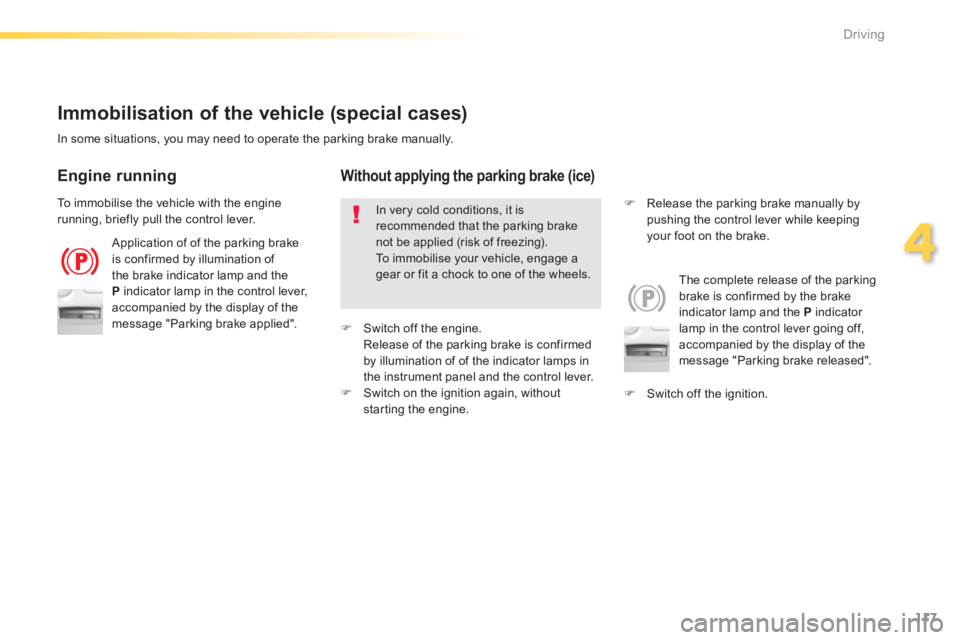
117
4
Driving
308_EN_CHAP04_CONDUITE_ED02-2013
Immobilisation of the vehicle (special cases)
Application of of the parking brake is confirmed by illumination of the brake indicator lamp and the P indicator lamp in the control lever, accompanied by the display of the message "Parking brake applied".
The complete release of the parking brake is confirmed by the brake indicator lamp and the P indicator lamp in the control lever going off, accompanied by the display of the message "Parking brake released".
In some situations, you may need to operate the parking brake manually.
Engine running
In very cold conditions, it is
recommended that the parking brake not be applied (risk of freezing). To immobilise your vehicle, engage a gear or fit a chock to one of the wheels.
Without applying the parking brake (ice)
Switch off the ignition.
Release the parking brake manually by pushing the control lever while keeping your foot on the brake.
To immobilise the vehicle with the engine running, briefly pull the control lever.
Switch off the engine. Release of the parking brake is confirmed by illumination of of the indicator lamps in the instrument panel and the control lever. Switch on the ignition again, without starting the engine.
Page 122 of 400
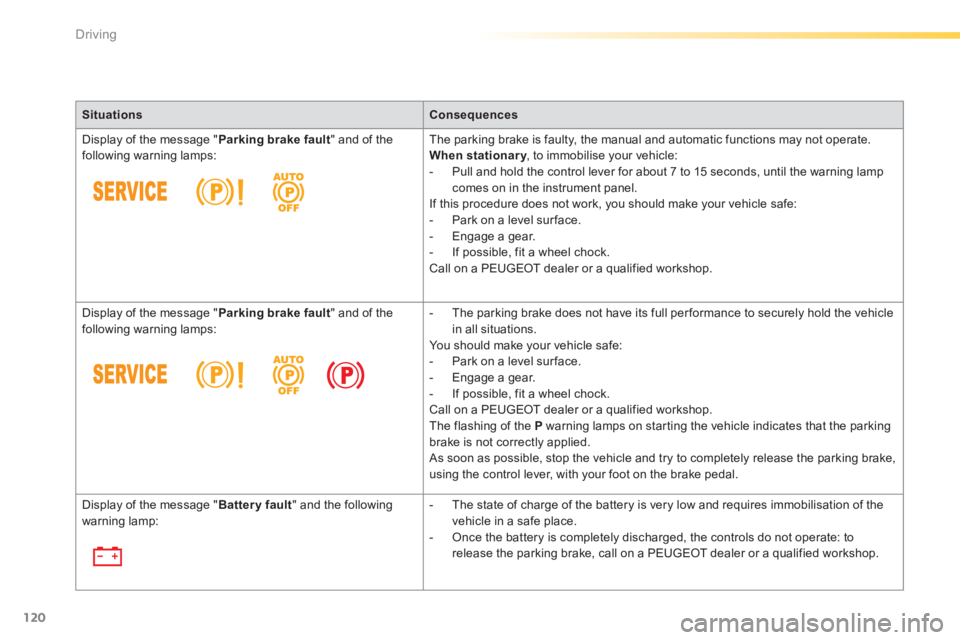
120
Driving
308_EN_CHAP04_CONDUITE_ED02-2013
SituationsConsequences
Display of the message " Parking brake fault " and of the following warning lamps: The parking brake is faulty, the manual and automatic functions may not operate. When stationary , to immobilise your vehicle: When stationary , to immobilise your vehicle: When stationary - Pull and hold the control lever for about 7 to 15 seconds, until the warning lamp comes on in the instrument panel. If this procedure does not work, you should make your vehicle safe: - Park on a level sur face. - Engage a gear. - If possible, fit a wheel chock. Call on a PEUGEOT dealer or a qualified workshop.
Display of the message " Parking brake fault " and of the following warning lamps: - The parking brake does not have its full per formance to securely hold the vehicle in all situations. You should make your vehicle safe: - Park on a level sur face. - Engage a gear. - If possible, fit a wheel chock. Call on a PEUGEOT dealer or a qualified workshop. The flashing of the P warning lamps on starting the vehicle indicates that the parking brake is not correctly applied. As soon as possible, stop the vehicle and try to completely release the parking brake, using the control lever, with your foot on the brake pedal.
Display of the message " Battery fault " and the following warning lamp: - The state of charge of the battery is very low and requires immobilisation of the vehicle in a safe place.
- Once the battery is completely discharged, the controls do not operate: to release the parking brake, call on a PEUGEOT dealer or a qualified workshop.
Page 135 of 400
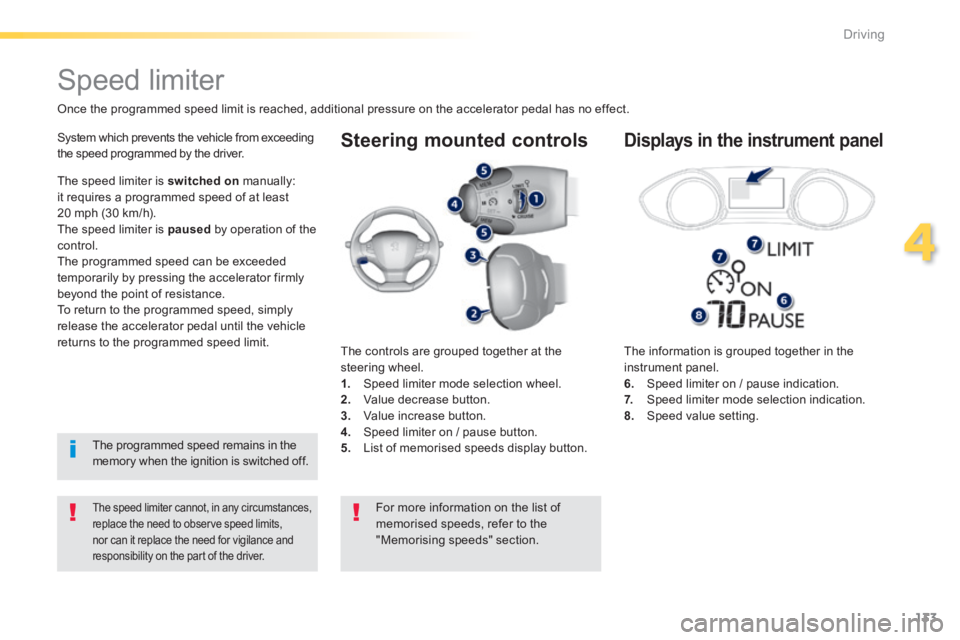
133
4
Driving
308_EN_CHAP04_CONDUITE_ED02-2013
Steering mounted controls
The information is grouped together in the instrument panel. 6. Speed limiter on / pause indication. 7. Speed limiter mode selection indication. 8. Speed value setting.
Speed limiter
Once the programmed speed limit is reached, additional pressure on the accelerator pedal has no effect.
The speed limiter cannot, in any circumstances, replace the need to observe speed limits, nor can it replace the need for vigilance and responsibility on the part of the driver.
System which prevents the vehicle from exceeding the speed programmed by the driver.
The controls are grouped together at the steering wheel. 1. Speed limiter mode selection wheel. 2. Value decrease button. 3. Value increase button. 4. Speed limiter on / pause button. 5. List of memorised speeds display button.
Displays in the instrument panel
The speed limiter is switched on manually: it requires a programmed speed of at least 20 mph (30 km/h). The speed limiter is paused by operation of the control. The programmed speed can be exceeded temporarily by pressing the accelerator firmly beyond the point of resistance. To return to the programmed speed, simply release the accelerator pedal until the vehicle returns to the programmed speed limit.
The programmed speed remains in the memory when the ignition is switched off.
For more information on the list of memorised speeds, refer to the "Memorising speeds" section.
Page 136 of 400
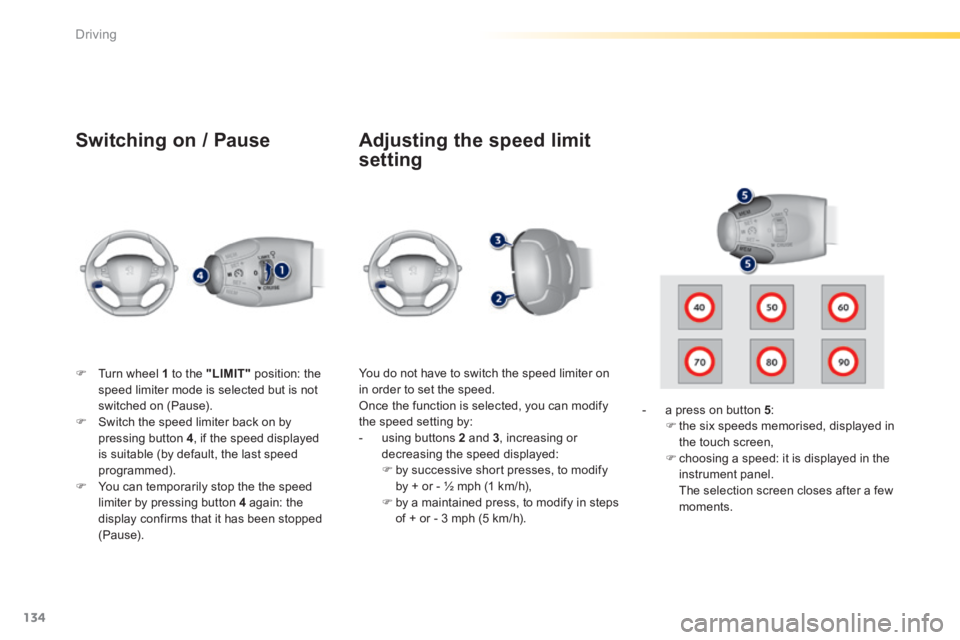
134
Driving
308_EN_CHAP04_CONDUITE_ED02-2013
Switching on / Pause
Turn wheel 1 to the "LIMIT" position: the speed limiter mode is selected but is not switched on (Pause). Switch the speed limiter back on by pressing button 4 , if the speed displayed is suitable (by default, the last speed programmed). You can temporarily stop the the speed limiter by pressing button 4 again: the display confirms that it has been stopped (Pause).
You do not have to switch the speed limiter on in order to set the speed. Once the function is selected, you can modify the speed setting by: - using buttons 2 and 3 , increasing or decreasing the speed displayed: by successive short presses, to modify by + or - ½ mph (1 km/h), by a maintained press, to modify in steps of + or - 3 mph (5 km/h).
- a press on button 5 : the six speeds memorised, displayed in the touch screen, choosing a speed: it is displayed in the instrument panel. The selection screen closes after a few moments.
Adjusting the speed limit
setting
Page 137 of 400
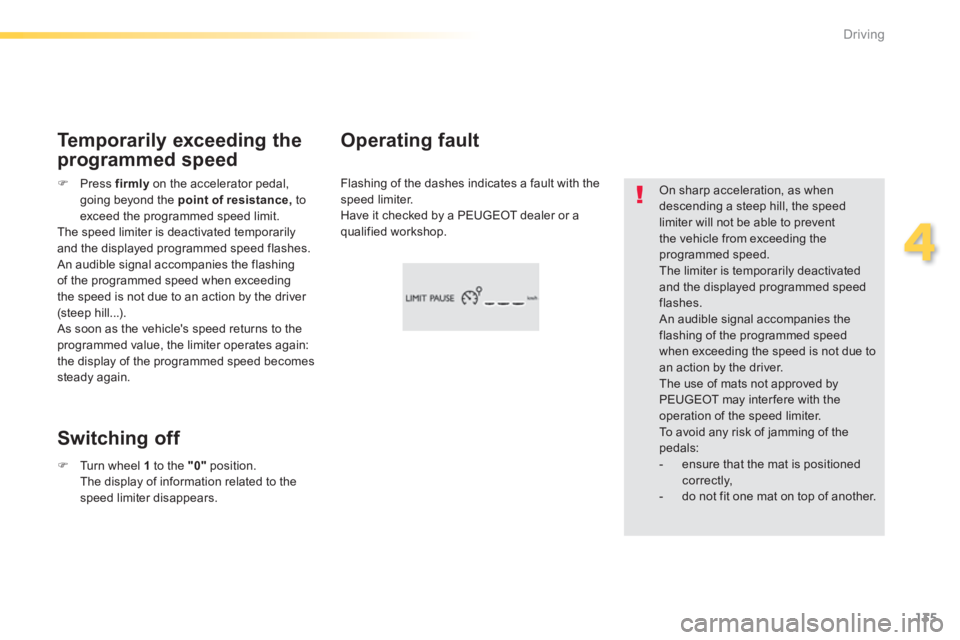
135
4
Driving
308_EN_CHAP04_CONDUITE_ED02-2013
On sharp acceleration, as when descending a steep hill, the speed limiter will not be able to prevent the vehicle from exceeding the programmed speed. The limiter is temporarily deactivated and the displayed programmed speed flashes. An audible signal accompanies the flashing of the programmed speed when exceeding the speed is not due to an action by the driver. The use of mats not approved by PEUGEOT may inter fere with the operation of the speed limiter. To avoid any risk of jamming of the pedals: - ensure that the mat is positioned c o r r e c t l y, - do not fit one mat on top of another.
Flashing of the dashes indicates a fault with the speed limiter. Have it checked by a PEUGEOT dealer or a
qualified workshop.
Operating fault Temporarily exceeding the
programmed speed
Switching off
Press firmly on the accelerator pedal, going beyond the point of resistance, to exceed the programmed speed limit. The speed limiter is deactivated temporarily and the displayed programmed speed flashes. An audible signal accompanies the flashing of the programmed speed when exceeding the speed is not due to an action by the driver (steep hill...). As soon as the vehicle's speed returns to the programmed value, the limiter operates again: the display of the programmed speed becomes steady again.
Turn wheel 1 to the "0" position. The display of information related to the speed limiter disappears.
Page 138 of 400

136
Driving
308_EN_CHAP04_CONDUITE_ED02-2013
Steering mounted controls
The information is grouped together in the instrument panel. 6. Cruise control pause / resume indication. 7. Cruise control mode selection indication. 8. Speed value setting.
Cruise control
System which automatically maintains the speed of the vehicle at the value programmed by the driver, without any action on the accelerator pedal.
The cruise control system cannot, in any circumstances, replace the need to observe speed limits, nor can it replace the need for vigilance and responsibility on the part of the driver. You are advised to keep your feet near the pedals
at all times.
The cruise control is switched on manually: it requires a minimum vehicle speed of 25 mph (40 km/h).
The controls of this system are grouped together at the steering wheel. 1. Cruise control mode selection wheel. 2. Decrease value or speed setting on the fly button. 3. Increase value or speed setting on the fly
button. 4. Cruise control pause / resume button. 5. Memorised speeds display button.
Displays in the instrument panel
Switching off the ignition cancels any programmed speed value.
The cruise control is paused manually or by pressing the brake or clutch pedal or on triggering of the ESC system for safety reasons. It is possible to exceed the programmed speed temporarily by pressing the accelerator pedal. To return to the programmed speed, simply release the accelerator pedal until the programmed cruise speed is reached again.
As well as the engagement of at least third or fourth gear (depending on engine) on a manual gearbox.
For more information on the list of
memorised speeds, refer to the "Memorising speeds" section.
As well as the engagement of at least second
gear (depending on engine) on an automatic gearbox.
Page 139 of 400
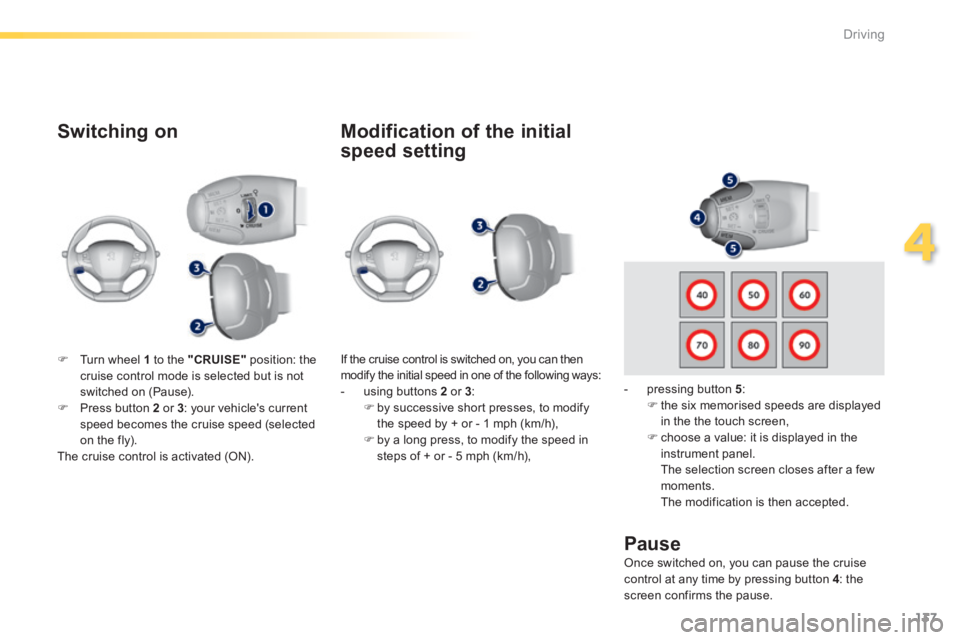
137
4
Driving
308_EN_CHAP04_CONDUITE_ED02-2013
Switching on
If the cruise control is switched on, you can then modify the initial speed in one of the following ways: - using buttons 2 or 3 : by successive short presses, to modify the speed by + or - 1 mph (km/h), by a long press, to modify the speed in steps of + or - 5 mph (km/h),
Pause
Turn wheel 1 to the "CRUISE" position: the cruise control mode is selected but is not switched on (Pause). Press button 2 or 3 : your vehicle's current speed becomes the cruise speed (selected on the fly). The cruise control is activated (ON).
Modification of the initial
speed setting
- pressing button 5 : the six memorised speeds are displayed in the the touch screen,
choose a value: it is displayed in the instrument panel. The selection screen closes after a few moments. The modification is then accepted.
Once switched on, you can pause the cruise control at any time by pressing button 4 : the screen confirms the pause.
Page 140 of 400
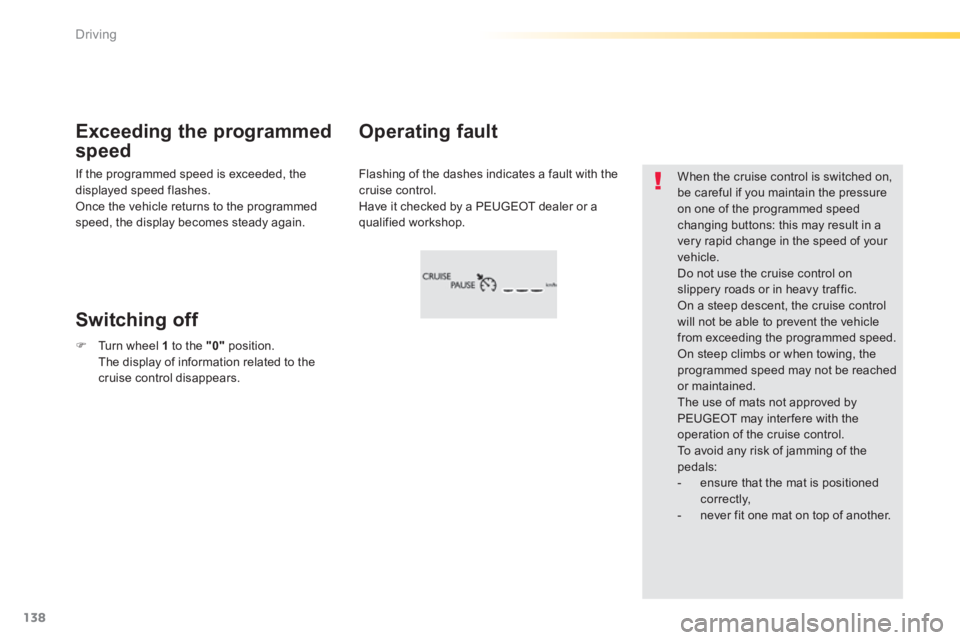
138
Driving
308_EN_CHAP04_CONDUITE_ED02-2013
Flashing of the dashes indicates a fault with the cruise control. Have it checked by a PEUGEOT dealer or a qualified workshop.
Operating fault Exceeding the programmed
speed
Switching off
When the cruise control is switched on, be careful if you maintain the pressure on one of the programmed speed
changing buttons: this may result in a very rapid change in the speed of your vehicle. Do not use the cruise control on slippery roads or in heavy traffic. On a steep descent, the cruise control will not be able to prevent the vehicle from exceeding the programmed speed. On steep climbs or when towing, the programmed speed may not be reached or maintained. The use of mats not approved by PEUGEOT may inter fere with the operation of the cruise control. To avoid any risk of jamming of the pedals: - ensure that the mat is positioned c o r r e c t l y, - never fit one mat on top of another.
If the programmed speed is exceeded, the displayed speed flashes. Once the vehicle returns to the programmed speed, the display becomes steady again.
Turn wheel 1 to the "0" position. The display of information related to the cruise control disappears.